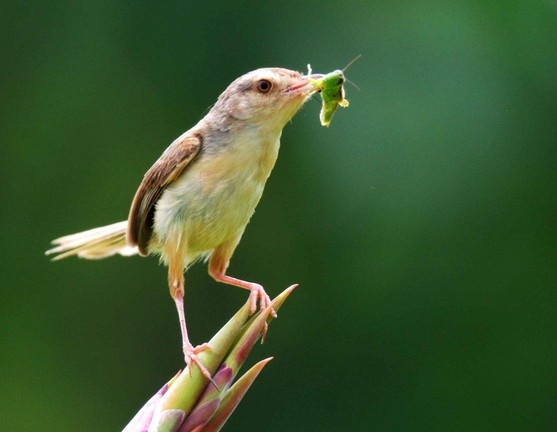Everyone is familiar with the sight of robins hopping around the yard, peering into the grass or “head-cocking” to locate a nice juicy worm. In no time, they find their prey and fly off with a mouthful.
后院里,知更鸟跳来跳去,注视着草丛,晃头晃脑地搜寻着可口多汁的昆虫。这样的情景相信大家都不陌生。一旦发现“猎物”,它马上叼着虫儿飞走了。
Cues to find prey
寻找猎物的线索
Birds are known to use visual, auditory, and possibly vibrations or tactile cues to find prey, but vision is predominant.
通常鸟儿们是通过视觉、听觉,有时可能是触觉(昆虫的振动)这些线索来寻找猎物,其中视觉居多。
The way the robins turn their head when searching for food suggests they could be using visual or auditory cues, but it wasn’t until scientists tested robins in the lab that we really knew for sure how they find worms.
从知更鸟晃头晃脑地寻找食物可以推断出视觉和听觉线索的利用,但是直到科学家们在实验室中测试,我们才真正明确知更鸟如何发现昆虫。

Testing the birds
测试鸟儿
Birds were placed in aviaries where they could be given buried mealworms in trays of dirt.
在大型鸟舍中,给鸟儿们提供面粉虫藏在泥里的托盘。
To test if they were using scent to locate their prey, birds were offered trays with buried live, moving worms and dead ones. Robins found the live worms more often, suggesting they were not using scent.
为了测试鸟儿是否通过嗅觉寻找猎物,托盘里分别藏有活着的昆虫和死了的昆虫。知更鸟找出的多是活着的昆虫,这说明知更鸟寻找猎物时并没有利用嗅觉。
In the next test, they were given hanging food trays to keep them from touching the soil with their feet and detecting the worm’s vibrations. The trays did not affect their ability to find the worms, suggesting they do not use tactile cues.
下一个测试是:把托盘悬挂起来,这样知更鸟的脚碰不到泥土,也不能探测昆虫的振动。测试并没有影响知更鸟捕捉昆虫,这说明知更鸟寻找猎物时并没有利用触觉。
Sound Cues
声音线索
When cardboard was used as a barrier to block visual cues, the birds could still find the worms. That meant they were using another sense. A last experiment used white noise to block sound cues and the birds had more difficulty finding the worms.
用纸板作为障碍物破坏视觉线索,鸟儿依然能找到昆虫。说明鸟儿是用另种线索。最后的实验利用白色噪音破坏声音线索,鸟儿寻找昆虫困难起来了。
The research concluded that robins could use either visual or auditory cues alone to find worms in the soil, but probably use both. So the next time you see a robin “head-cocking” you can be fairly sure it’s listening and looking for those mouthwatering treats!
研究结果是知更鸟可以利用视觉或听觉中任一线索寻找泥土中的昆虫,但是也很可能是两种皆有。所以,下次你再看见知更鸟在草丛中摇头晃脑的,你可以确定它们是通过听觉寻找垂涎的美味了!



